Related Research Articles

J. R. R. Tolkien's The Fall of Gondolin is one of the stories which formed the basis for a section in his posthumously-published work, The Silmarillion, with a version later appearing in The Book of Lost Tales. In the narrative, Gondolin was founded by King Turgon in the First Age; the city was carefully hidden, enduring for centuries before being betrayed and destroyed.
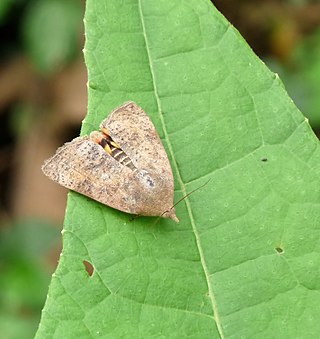
Hyblaeidae are the "teak moths", a family of insects in the Lepidopteran order. The two genera with about 18 species make up one of the two families of the Hyblaeoidea superfamily, which in the past has been included in the Pyraloidea. Recent phylogenetic studies find varying relationships of Hyblaeoidea among Ditrysian Lepidoptera: Mutanen et al. (2010) find the superfamily to group either with Pyraloidea, or – more often – with Thyridoidea or butterflies. The results of Wahlberg et al. (2013) and Heikilä et al. (2015) indicate a sister-group relationship with Pyraloidea.

The Batrachedridae are a small family of tiny moths. These are small, slender moths which rest with their wings wrapped tightly around their bodies.
Kaila may refer to:

Arctia menetriesii, the Menetries' tiger moth, is a species of tiger moth in the family Erebidae. It was first described by Eduard Friedrich Eversmann in 1846. It is found in Karelia, Oktyabrskoe, northeastern Kazakhstan, Altai Mountains, Sayan Mountains, Evenkia, Yakutia, the central Amur region, Primorsky Krai and central Sakhalin. It was believed to be extinct in Fennoscandia, but the species has been recently recorded in Finland. This species is characterized by the fact that they never come to light; such behavior is atypical in the family Arctiidae.
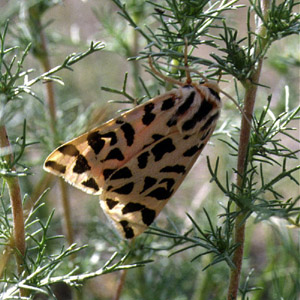
Chelis mongolica is a species of tiger moth in the family Erebidae, described by Sergei Alphéraky in 1888. It is found in the Gobi Desert and neighboring arid territories.

Diacrisia is a genus of tiger moths in the family Erebidae. The genus was erected by Jacob Hübner in 1819. Its species can be found in Europe and Asia.
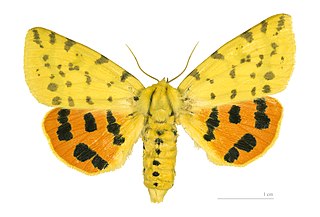
Diacrisia purpurata, the purple tiger, is a moth of the subfamily Arctiinae. The species was first described by Carl Linnaeus in his 1758 10th edition of Systema Naturae. It is found in Europe, Anatolia, Syria, Transcaucasus, Central Asia, southern Siberia, Mongolia, Amur Region, northern China, Korea and Japan (Honshu).
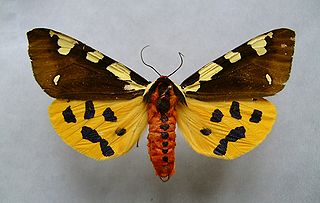
Arctia is species of tiger moth in the family Erebidae. It was first described by Carl Linnaeus in his 1758 10th edition of Systema Naturae. It can be found in central and eastern Europe, Kazakhstan, southern Siberia, northern Mongolia, Amur Region, Primorye, Sakhalin, Kunashir, northern and northeastern China, Korea and Japan.

Arctia tigrina is a moth of the family Erebidae. It is found on the Iberian Peninsula and the South of France and Italy.

Arctia aulica, the brown tiger moth, is a moth of the family Erebidae. The species was first described by Carl Linnaeus in his 1758 10th edition of Systema Naturae. It is found in the temperate areas of central Europe up to the area surrounding the Amur River to the east and up to the Balkans and the Black Sea to the south.
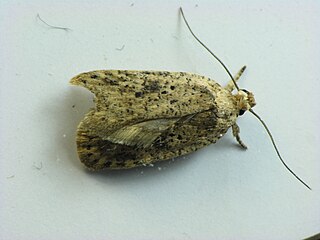
Depressariidae is a family of moths. It was formerly treated as a subfamily of Gelechiidae, but is now recognised as a separate family, comprising about 2,300 species worldwide.

Perittia is a genus of moths of the family Elachistidae.
Coelopoeta maiadella is a moth in the superfamily Gelechioidea. It is found in Yukon, Canada.
Arctia dido is a moth of the family Erebidae. It was described by M. Wagner in 1841. It is found in Algeria.
Arctia oberthueri is a moth of the family Erebidae. It was described by Charles Oberthür in 1890. It is found in Algeria and Tunisia.
Arctia ungemachi is a moth of the family Erebidae. It was described by Ferdinand Le Cerf in 1924. It is found in Morocco.

Diacrisia metelkana is a moth in the family Erebidae. It was described by Julius Lederer in 1861. It is found in southern and central Europe, Russia, eastern Asia and Japan.
Elachista arthadella is a moth of the family Elachistidae first described by Lauri Kaila in 1999. It is found in the United States, where it has been recorded from Oregon.
Elachista suavella is a moth of the family Elachistidae. It is found in the United States, where it has been recorded from Arizona.
References
- ↑ "Profile of Lauri Kaila on ResearchGate". researchgate.net. Retrieved 31 August 2018.
- ↑ "Lauri Kaila taxa on WikiSpecies". species.wikimedia.org. Retrieved 31 August 2018.